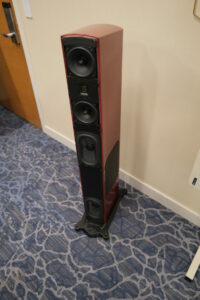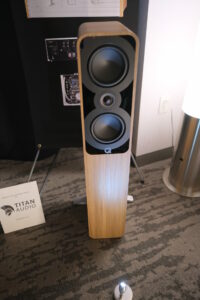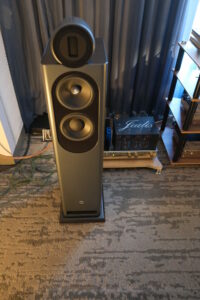Uncategorized
Acora Acoustics SRB Loudspeaker
As a breed, high-end speaker designers are inclined to be keen about their very own specific design predilections. Andrew Jones wouldn’t dream of constructing a speaker that lacked coincident drivers. Daryl Wilson is adamant in regards to the significance of inter-driver timing. Magico’s Alon Wolf will construct a ported enclosure when hell freezes over.
Valerio Cora, founder and designer of Acora Acoustics, the relative newcomer who has already made main waves within the business, is equally passionate. In his case, the thing of his fervor is stone. Indeed, Cora’s obsession with using stone for speaker cupboards goes past mere philosophy. For him, the choice for stone is private.
Cora spent three months in Italy yearly till he was 18 years previous as a part of a household whose enterprise was stonework and machining. His father served as his mentor, instructing him the intricacies of varied stones: their traits, the best way to work with them, the best way to choose the very best. Cora is aware of the fabric intimately as a result of, in a really actual sense, stone is in his blood.
But Cora is a scientist by coaching, so if you happen to ask him why he selected stone—particularly granite—for his flagship SR speaker collection enclosures, he gained’t regale you with tales of his youth. Instead, he’ll dispassionately clarify why “it’s merely the very best materials to make a speaker out of.” Why? “It’s steady. It’s inert. It’s inflexible. It doesn’t bend, deflect, or compress. It holds the drivers exactly in place, with no motion, and it doesn’t permit the rear wave to work together with the entrance wave. Granite doesn’t permit sound waves to penetrate by means of it or contribute any sound waves of its personal.”
Ask him his emotions towards different widespread speaker supplies and also you’ll get a terse response. Wood? “Not sufficiently stiff or dense. Too compressive. Not hermetic.” Aluminum? “Better, however nonetheless extra elastic and fewer dense than granite.” One knock Cora has towards just about all non-stone enclosures is that they require bracing to realize sufficient stiffness. In his ebook, bracing is dangerous as a result of “sound waves from the again of the drivers mirror off the bracing and are available again to the entrance of the drivers.” Consequently, Acora audio system eschew bracing altogether. Besides being sonically deleterious, bracing is superfluous in a speaker fabricated from granite.
Nor is Cora any extra complaisant relating to different features of speaker design. For occasion, all Acora audio system are 2-way. The cause? “It’s practically unattainable to realize section coherence with a 3-way passive crossover. You all the time must make extra compromises than with a 2-way.” Nor are Acora audio system
time-aligned within the vein of a Wilson, Vandersteen, or Rockport. Like Magico’s Wolf, Cora feels that “time-aligning drivers creates compromises that outweigh the advantages. Also, it’s bodily unattainable to be time aligned in any respect frequencies. But we make use of a sloped baffle to realize a phase-coherent alignment between the drivers.” How about first-order crossovers, then? “No. Too a lot driver overlap between drivers—as much as six octaves on the crossover frequencies.” And as for sealed enclosures, “I desire the bass extension of ported designs.”
Cora is equally choosy about his drivers. For instance, he doesn’t use diamond-coated tweeters, saying, “Maybe sooner or later. Right now, they don’t meet my sonic goal. Remember, if you happen to’re coating one thing, you’re including weight to it.”
Nowhere will you discover extra proof of Cora’s uncompromising exactitude than on the matter of granite coloration. The SR Series audio system are, like a Model T Ford, accessible in any coloration you’d like as long as it’s black. That appears draconian, however, as all the time, Cora has causes grounded in information. “Different colours of granite have completely different densities, all decrease than black. Veins of coloration are literally cracks which have been fused collectively by mom nature. This leads to a weaker construction with completely different resonant properties. Black doesn’t have any of those issues.”
And so it’s that for Acora’s entry-level speaker within the high SR Series, the $18,750 SRB, Val Cora constructed a 2-way, ported, brace-free, stand-mounted speaker with a non-diamond-coated beryllium tweeter, a 5.9″ mid/woofer, and a modified 4th-order crossover, all handsomely enclosed in a lustrous black granite cupboard. Yet, as you’ll see, this speaker doesn’t simply mirror its designer’s technical orientation; it manifests his very nature.
The Uncompromising Speaker
Just as Val Cora doesn’t compromise on his speaker designs, his SR Series audio system don’t compromise on sound high quality. They inform the reality of what’s on the recording, and nothing however. They’re among the many most revealing audio system I’ve ever encountered, however there’s no sugar coating. Speakers for the “As You Like It” crowd, these aren’t.
Like all ultra-revealing audio system, the SRB calls for an immaculate setup. Don’t even take into consideration cheaping out on cables or amplification. Even amongst costly, reference-class choices, you’ll wish to select properly. Cardas cables, for example, are identified to be full within the bass. This is a fortuitous attribute in lots of setups, however I discovered the Cardas Clear a would possibly too fulsome for the Acoras, which, regardless of their measurement, are on no account bass shy. I used to be happier with my customary Empirical Design speaker cables, that are extra impartial.
And whereas I bought usually good outcomes with my CH Precision I1 built-in amp, I couldn’t eradicate a persistent shrillness within the decrease treble. This will not be a attribute of the amp nor, as I used to be to be taught, of the speaker; moderately, it was a lower than preferrred pairing.
Since Cora voices and reveals his audio system primarily with tubed gear, I assumed it smart to borrow some to see what would occur. And as a result of the audio system thrive on impartial related tools, I sought out two tubed elements that JV had just lately highlighted as a few of the most impartial such merchandise he’d encountered: the Audio Research Reference 160S stereo energy amp and Reference 6SE linestage. A name went out to Dave Gordon at ARC, and earlier than I knew it, my pals at JS Audio in Bethesda, Maryland, had offered me samples of those luscious elements. The ARC duo labored wonders on the shrillness I’d beforehand encountered.
When it involves putting the SRB, some exactitude is required. You’ll wish to give these audio system a large stance, with loads of distance between them and solely a contact of toe-in. That mentioned, the audio system are surprisingly versatile relating to distance from the wall behind them. That is, they’re equally amenable to being effectively out from that wall or in a room that forces them nearer to it.
Of course, you’ll want stands—and never simply any stands. Acora makes two which can be particularly designed for the SRB. In my view, utilizing these, versus generics, is obligatory. To carry out as supposed, the SRBs should be tightly coupled to the ground. The Acora stands try this.
The two fashions are the steel-and-granite SRS-M ($3125) and the considerably heavier, all-granite SRS-G ($6250). Normally, I’d have gone for the full-granite choice, since Cora instructed me in no unsure phrases that it sounds higher. However, the all-granite stands have a barely broader base than the steel variations, and that will have conflicted with my media console. This overview, then, is predicated on the audio system being positioned atop the SRS-M stands. It’s good to know that, house and price range allowing, even higher sound may be wrung from the SRS by utilizing the SRS-G stands.
After you get all this sorted out, you’ll wish to run within the audio system for an extended spell earlier than contemplating them damaged in. Anything lower than 200 hours, and also you’ll hear a paucity within the treble. Don’t fear; it goes away.
Once every little thing is true, the little SRB dazzles with wonderful feats. Play a superb piano recording—I sometimes use Michael Wolff’s 2am—and also you’ll marvel at how a lot slop you’ve been listening to from different audio system. Listen to any good jazz-bass recording and also you gained’t consider the deep, highly effective, punchy, detailed lows you’re getting from such a compact design.
This low-end decision extends to pop recordings, as effectively. On Kacey Musgrave’s “Slow Burn,” there’s an especially delicate bass line that accompanies the guitar by means of the opening verse. I by no means heard it earlier than I had the SRBs in my system. That’s the kind of musically significant materials the SRBs unearth. Indeed, attempt them with any acquainted recording and I dare you to not hear some element—or be higher in a position to distinguish and comply with an obscured musical line—that had beforehand gone unnoticed.
You’ll additionally get a greater than credible 3-D soundstage, even when the audio system are lower than a foot from the wall behind them. As for imaging, it’s as very good as you’d count on from a well-sorted, two-way mini-monitor with an enclosure that’s actually laborious as a rock.
Vocals? You’re going to listen to each ingredient of the singer’s instrument. Try Satchmo on “St. James Infirmary.” Everything that makes him singular, from tone to model to delicate inflections, is laid naked. Or placed on Tracy Chapman having her inimitable approach with a stay rendition of “Stand by Me.” Her uniqueness and prowess are overwhelming.
The SRB can also be superb at one thing that eludes many audio system, even these which can be in any other case of reference caliber: dynamic monitoring. I’m not referring to the flexibility to play tender and loud, or to transition fleetly from one to the opposite, although the SRB completely does these issues, too. What I imply is a speaker’s capacity to take care of coherence and tonal steadiness by means of various dynamics. The SRB—and all Acora audio system, in my expertise—do that to a fare-thee-well.
At the identical time, the SRB’s uncompromising nature implies that it’s not for everybody. If there are issues with a recording, you’re going to listen to them. For occasion, Led Zeppelin’s “Black Dog,” regardless of the model, is unremittingly skinny. The SRB does nothing to cover this truth. Mind you, the Acora doesn’t exaggerate flaws in supply materials; it simply doesn’t disguise or compensate for them.
Which makes it value noting that the SR Series will not be the one mannequin line Acora presents. The firm just lately launched the QR Series. Each QR mannequin is equivalent to its SR counterpart save that it’s fabricated from quartz moderately than granite. You may even get them in colours apart from black! Those are compromises, true, however Cora was sanguine about them as a result of the QR Series is extra forgiving but retains 95% of the SR’s sound high quality. QR fashions are additionally 20% inexpensive than their granite counterparts.
Which one is best for you? If you’re prepared to surrender that 5% of the SRB’s efficiency for a extra forgiving presentation, the QRB may have your identify on it. But if it’s uncompromising efficiency you search from a compact, stand-mounted speaker—the last word in decision, dynamics, imaging, and musically related element—the Acora SRB must be in your must-audition listing.
Specs & Pricing
Type: 2-way bass-reflex standmount
Drivers: 5.9″ sandwich paper cone midrange/woofer, 1″ beryllium dome tweeter
Enclosure: High-polish, pure black granite
Crossover frequency: 3.3kHz
Impedance: 8 ohms
Recommended amplifier energy: 10W–150W
Sensitivity: 86.5dB/1W/1m
Frequency response: 43Hz–35KHz
Dimensions: 9″ x 13″ x 11″
Weight: 58 lbs. every with out stands
Price: $18,750/pr.
ACORA ACOUSTICS
165 Milner Ave,
Scarborough, ON
Canada
M1S 4G7
acoraacoustics.com
(647) 812-3933
The put up Acora Acoustics SRB Loudspeaker appeared first on The Absolute Sound.









